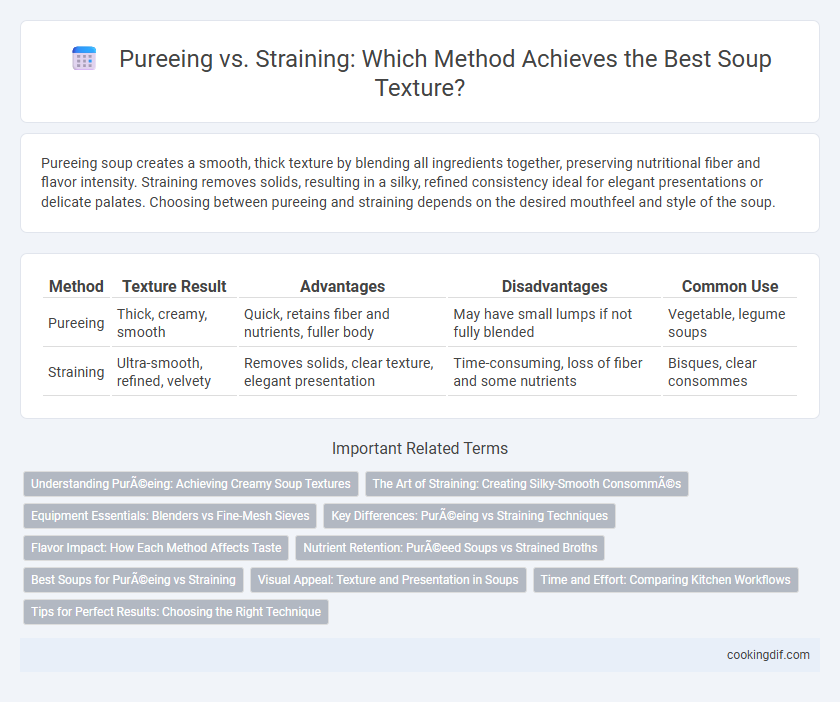Pureeing soup creates a smooth, thick texture by blending all ingredients together, preserving nutritional fiber and flavor intensity. Straining removes solids, resulting in a silky, refined consistency ideal for elegant presentations or delicate palates. Choosing between pureeing and straining depends on the desired mouthfeel and style of the soup.
Table of Comparison
| Method | Texture Result | Advantages | Disadvantages | Common Use |
|---|---|---|---|---|
| Pureeing | Thick, creamy, smooth | Quick, retains fiber and nutrients, fuller body | May have small lumps if not fully blended | Vegetable, legume soups |
| Straining | Ultra-smooth, refined, velvety | Removes solids, clear texture, elegant presentation | Time-consuming, loss of fiber and some nutrients | Bisques, clear consommes |
Understanding Puréeing: Achieving Creamy Soup Textures
Pureeing transforms soup ingredients into a smooth, creamy texture by blending solids and liquids until fully emulsified. This technique enhances the mouthfeel and allows flavors to meld uniformly, creating rich, velvety soups like butternut squash or tomato bisque. Unlike straining, pureeing retains all the fibrous content, boosting nutritional value and providing a satisfying body to the soup.
The Art of Straining: Creating Silky-Smooth Consommés
Straining is essential in achieving the silky-smooth texture characteristic of consommes, as it removes impurities and fine particles that blending alone cannot eliminate. Using fine mesh strainers or cheesecloth ensures a crystal-clear, refined liquid that highlights the soup's delicate flavors. This meticulous process transforms the broth into an elegant, velvety consomme prized in gourmet cuisine.
Equipment Essentials: Blenders vs Fine-Mesh Sieves
Blenders provide a quick and efficient way to puree soups, creating a smooth texture by breaking down ingredients thoroughly, ideal for creamy or chunky styles. Fine-mesh sieves are essential for straining, removing seeds, skins, or fibrous bits to achieve an ultra-smooth, refined consistency, especially in delicate soups like bisques or consommes. Investing in high-quality blenders and durable fine-mesh sieves ensures precise control over soup texture, enhancing both presentation and mouthfeel.
Key Differences: Puréeing vs Straining Techniques
Pureeing transforms soup ingredients into a smooth, thick consistency by blending all components together, retaining fibers and solids for a fuller texture. Straining removes solids through a sieve or cheesecloth, resulting in a clear, silky broth with a refined mouthfeel and concentrated flavors. The key difference lies in texture: pureeing preserves body and richness, while straining emphasizes clarity and smoothness.
Flavor Impact: How Each Method Affects Taste
Pureeing soups blends all ingredients into a smooth, creamy texture that intensifies the flavor by fully incorporating solids and liquids, enhancing the overall richness and body. Straining removes solids to create a clear, silky broth, concentrating the flavors without any textural interference, which sharpens the taste and highlights individual ingredients. Choosing between pureeing and straining significantly influences the soup's flavor profile, with pureeing offering depth and creaminess, while straining emphasizes clarity and refinement.
Nutrient Retention: Puréeed Soups vs Strained Broths
Pureeing soups preserves more fiber, vitamins, and minerals by retaining the entire vegetable content in a smooth, thick texture, enhancing nutrient density. Straining broths removes solids, reducing fiber and some micronutrients but yielding a clear, lighter soup ideal for delicate digestion and flavor clarity. Choosing pureeed soups maximizes nutrient retention, while strained broths offer a more refined texture with fewer nutrients.
Best Soups for Puréeing vs Straining
Pureeing is ideal for creamy vegetable soups like butternut squash and tomato bisque, where a smooth, velvety texture enhances flavor absorption. Straining is best suited for broths and consommes, providing a clear, refined finish by removing solid particles and impurities. Choosing between pureeing and straining depends on the desired mouthfeel and presentation of the soup.
Visual Appeal: Texture and Presentation in Soups
Pureeing soups creates a smooth, velvety texture that enhances visual appeal through uniform consistency and vibrant color, making them ideal for elegantly plated dishes. Straining removes unwanted solids and ensures a silky clarity, providing a refined presentation that highlights the soup's bright ingredients and garnishes. Both methods influence texture and presentation significantly, allowing chefs to tailor soups for a polished, gourmet look.
Time and Effort: Comparing Kitchen Workflows
Pureeing soup typically requires less time and effort as it involves using a blender or immersion blender to quickly achieve a smooth texture, making it ideal for busy kitchens. Straining demands more patience and precision, involving the use of a fine-mesh sieve or cheesecloth to remove solids, resulting in a silkier consistency but extended preparation time. Choosing between pureeing and straining impacts workflow efficiency, with pureeing streamlining the process while straining enhances texture at the cost of increased labor.
Tips for Perfect Results: Choosing the Right Technique
Pureeing soup creates a smooth, creamy texture by blending ingredients thoroughly, ideal for hearty dishes like butternut squash or tomato bisque. Straining removes solids and yields a silky, delicate consistency, perfect for refined soups such as consomme or veloute. Select pureeing for rustic richness or straining for elegance based on desired mouthfeel and presentation.
Puréeing vs Straining for texture Infographic

 cookingdif.com
cookingdif.com